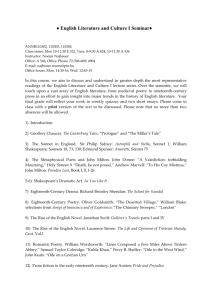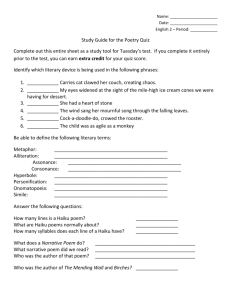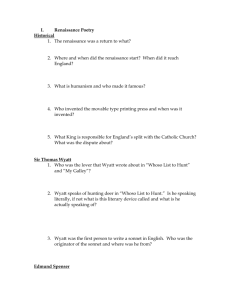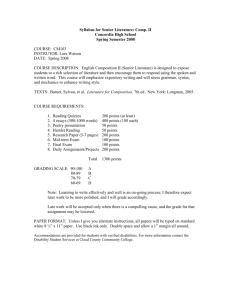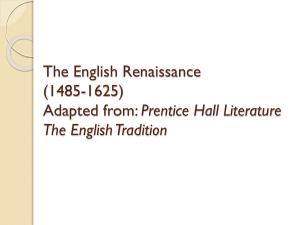Presentation
advertisement
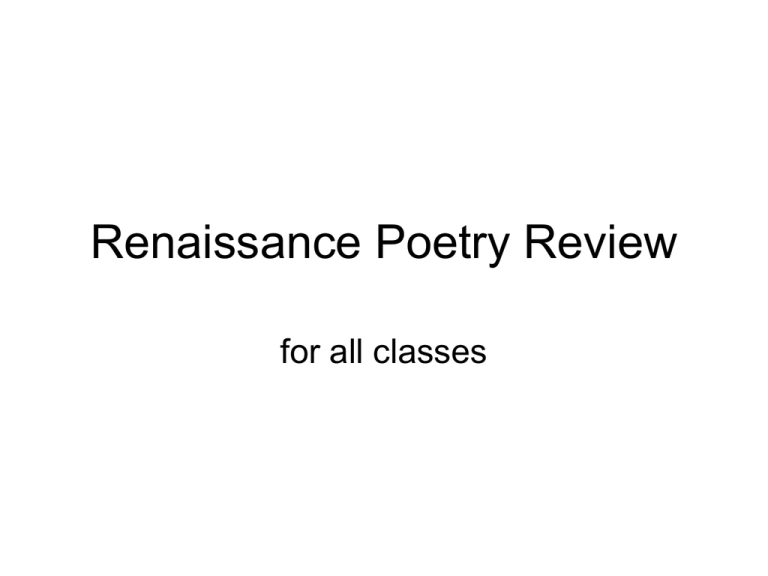
Renaissance Poetry Review for all classes Description of test • 50 scantron questions (including information from the notes quiz, matching authors/titles, and multiple choice questions about the poems • 5 short discussion questions for everyone: you will be given a quote from a poem, and you must identify the poetic device in the quote and explain it • 1 longer discussion question for AP only • Please note that the questions in this review are similar (not necessarily identical) to the types of questions that will be on the test. • To what does the pronoun “his” refer in the following lines: “Love’s not Time’s fool, though rosy lips and cheeks within his bending sickle’s compass come.” • Answer: Time • What literary device is used to describe despair in the following line: “With shield of proof shield me from out the prease of those fierce darts Despair at me doth throw?” • Answer: personification • What literary device is used in the following line: “…not yet a breach, but an expansion, like gold to airy thinness beat” • Answer: simile • What device is used in the following line: “the indifferent judge between the high and low?” • Answer: personification • In “A Valediction: Forbidding Mourning,” what does “dull sublunary lovers’ love” refer to? • Answer: love based on physical attraction or physical presence • What literary device is used in this line: “a chamber deaf to noise and blind to light”: • Answer: personification • What Renaissance literary device is used in the last 3 stanzas of “A Valediction: Forbidding Mourning” ? • Answer: metaphysical conceit • What type of poem is sonnet 39; or, what literary device is the whole poem an example of? • Answer: apostrophe • What does the simile in the first two verses of “A Valediction” compare? • Answer: the dying of a “virtuous” man to the parting of two lovers—the farewell will be quiet and calm. • In sonnet 39, what do “high” and “low” refer to in the line, “the indifferent judge between the high and low” ? • Answer: “high” means the upper class; “low” means the lower or working class— the line generally refers to the idea that the “high” will often be privileged by a judge, though not by one who is indifferent. • This was published in 1611: • King James Bible • What does “rosy lips and cheeks” stand for in the following lines: “Love’s not Time’s fool, though rosy lips and cheeks within his bending sickle’s compass come.” • Answer: physical beauty, which is destroyed by time • What literary device is present in the following lines: “I, like an usurped town, to another due, labor to admit you, but oh, to no end.” • Answer: simile • What does “usurped” mean in the following lines: “I, like an usurped town, to another due, labor to admit you, but oh, to no end.” • Answer: seized or taken over unlawfully • The English navy defeated _______ in 1588. • Spanish Armada • In sonnet 75, the line, “but came the tide, and made my pains his prey,” the pronoun “his” refers to • Answer: the tide • In sonnet 75 the line, “but came the tide, and made my pains his prey,” “my pains” refers to… • Answer: the author’s writing of the woman’s name in the sand • This man brought the printing press to England • William Caxton • True or false: Renaissance writers believed poetry should fit expected forms and patterns. • true • In this poem, the Christian belief in the soul’s afterlife is a supporting idea but is not discussed in detail. • Answer: sonnet 10, “Death be not Proud” • “The Passionate Shepherd to his Love” is this type of poem: • Answer: pastoral • What literary device is contained in the following line: “Nor ever chaste, except you ravish me.” • Answer: paradox • Who brought the sonnet to England? • Thomas Wyatt • What literary device is contained in the following lines: “Yet dearly I love you, and would be loved fain, but am betrothed unto your enemy. Divorce me, untie, or break that knot again,” • Answer: metaphor • Name the poetic device contained in the following lines: “and then my state, like to the lark at break of day arising from sullen earth, sings hymns at heaven’s gate” • Answer: simile • Writer who first wrote sonnets in the 1300’s • Petrarch • From sonnet 75, the line, “My verse your virtues rare shall eternize,” means that • Answer: the writer’s poetry will make the woman’s goodness and beauty (‘virtues’) last forever • In “The Passionate Shepherd to his Love,” the lines “by whose falls/ melodious birds sing madrigals” is an example of what poetic device? • Answer: hyperbole (exaggeration) • Type of sonnet which has three quatrains and a couplet, and it has a new rhyme scheme for each quatrain • Shakespearean • This poem contains a simile in which the speaker compares the woman he loves to ice. • Answer: Spenser’s sonnet 30, “My love is like to ice” • What literary device is contained in the following line: “Thou art slave to fate, chance, kings, and desperate men” • Answer: personification • Type of sonnet which has three quatrains and a couplet, and has an interlocking rhyme scheme • Spenserian • What literary device is used in the following line from sonnet 116? • “It is the star to every wandering bark” • Answer: metaphor • This poetic device is a direct comparison between two unlike things. • Metaphor • Type of sonnet which has an octave and a sestet • Italian sonnet • Four lines of poetry which make up a section of a sonnet • quatrain • The speaker of this poem compares himself to fire. • Answer: Spenser’s sonnet 30, “My love is like to ice” • What two things are compared in the following lines: “and then my state, like to the lark at break of day arising from sullen earth, sings hymns at heaven’s gate” • Answer: the speaker’s state of mind is compared to a lark singing beautiful songs to heaven • The poetic form that portrays an idealized rural setting • pastoral • This poem contains a paradox describing unusual interactions of fire and ice. • Answer: Spenser’s sonnet 30, “My love is like to ice” • In Shakespeare’s sonnet 130 the speaker is making fun of other Renaissance poetry. What aspect of those poems does he mock? • Answer: the exaggerated comparisons used in other poems to idealize a woman’s beauty • the use of exaggeration to make a point, create humor, or express emotion is called _____________. • hyperbole • “Death be not Proud” is an example of which literary device, used to address an entity who will not answer the speaker? • Answer: apostrophe • From “Death be not Proud,” what does “thee” refer to in this line: “From rest and sleep, which but thy pictures be, much pleasure, then from thee much more must flow” • Answer: death • a statement that seems impossible or contradictory, but is true in the context in which it is written is a _________. • paradox • John Donne and Andrew Marvell wrote this type of poetry: • Metaphysical • The concluding couplet of this poem states that love is so powerful that it can alter the laws of nature. • Answer: Spenser’s sonnet 30, “My love is like to ice” • What two things are compared in the following line from sonnet 116: “It is the star to every wandering bark” • Answer “it” is love; love is compared to a star that guides a wandering ship • Why was Thomas More executed? • He opposed Henry VIII’s divorce • In which sonnet does the speaker explain that his flames are “increased manifold” by being exposed to extreme cold? • Answer: Spenser’s sonnet 30, “My love is like to ice” • One of the first English translations of the Bible was written in the 1520’s and 1530’s by ___. • William Tyndale • The Lord Chamberlain’s Men built ___________ in 1599. • The Globe Theatre • Give a paraphrase of the following line: • “With what I most enjoy contented least” • Answer: The things that I usually enjoy now give me absolutely no pleasure. • What poetic device is contained in the following line: “imprison me, for I, except you enthrall me, never shall be free” • Answer: paradox • Who helped spark the Protestant Reformation in 1517? • Martin Luther • In “The Nymph’s Reply to the Shepherd,” how does the speaker describe the gifts offered by the shepherd? • She says they will not last; they are full of folly. • What two things are compared in the following line: • “It is an ever-fixed mark, that looks on tempests and is never shaken.” • Answer: love is compared to a landmark that will always be fixed in place. • This was a movement supporting the idea that human beings can achieve greatness on their own abilities (as opposed to having everything controlled by God) • Humanism • Name the poetic devices in the following line: “But came the tide, and made my pains his prey.” • Answer: personification and metaphor (tide is personified as a predator; writing is compared to prey) • In which sonnet does the speaker describe his hatred of his own life and his envy for what other men have? • Answer: Shakespeare’s sonnet 29 • This was a time when people showed “renewed interest in science, art, and all learning,” and it helped England and Europe “transition” from the middle ages into the modern era. • renaissance • Which sonnet contains a conversation between a man and a woman? • Answer: sonnet 75 by Edmund Spenser, “One day I wrote her name” • What important Renaissance idea about poetry is expressed in the following line: • “my verse your virtues rare shall eternize” • Answer: Poetry can immortalize the goodness and beauty of a loved one. • Which word means ‘rebirth’ in French? • Renaissance • What literary device is contained in the following line: • “Love’s not Time’s fool, though rosy lips and cheeks within his bending sickle’s compass come.” • Answer: personification

